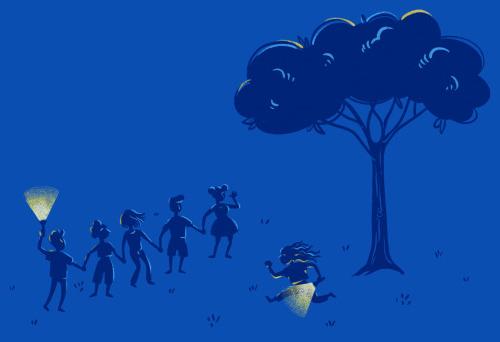When the lights went out
The meteorological record shows that April 14, 2003, was unseasonably warm — June perfection, two months early, with a high of 84 degrees.
Then, at 5:36 p.m., Beloit College Security began to receive reports of a power outage in several campus locations.
“After checking multiple transformer stations, Security and Maintenance discovered that a ‘blanket of fur’ lined the interior of one transformer box near M-I,” the Round Table wrote in its April 18, 2003, security report. “The experts ascertained that a chipmunk had crawled into the electric box and arced itself across two power phases, causing fuses to blow across campus.”
It was the spring of my freshman year at Beloit, and I remember the blackout only in the broadest strokes: It had something to do with a chipmunk (we learned this later), I was glad for the excuse to not have to write an anthropology paper, and I spent the night on the Haven quad, the center of gravity of that night’s spontaneous partying (Haven had power, and the quad was illuminated). I remember that I was in a bad mood, though I don’t remember why — just that I spent a lot of time moping on a porch swing in the glow of yellowy lights.
The power outages I have experienced as an adult have been boring at best, cause for panic about food spoilage or surviving summer heat with no air conditioning at worst, and they always make it frustratingly clear that my phone is basically a bionic device at this point. What made the chipmunk blackout so special? Was it just a fun night with no homework, or did it go deeper than that? Did anything like it ever happen before, or has it since?
The epic 2003 blackout
April 14 was a Monday, and Monday is not really a party night, even if you’re being liberal with your parties. With Spring Day two days away, finals approaching, and papers and projects coming due, most students would have been working, studying, or at least resting up from the weekend.
“When the power went out, it was just this liberating experience,” says Ellie Anderbyrne’05. “The whole campus is shut down and everyone is concentrated into a pretty small number of places they could be. And everyone knew — no professor would expect you to turn in your homework the next day.”
In the basement of Wood D, only half the double room shared by Marissa Berlin’05 and Kristina Wang’05 lost power, Berlin says.
“My computer was still on, hers had blinked off. One of our lamps was on, the other lost power,” Berlin says. “Kris and I panicked, then rejoiced, quickly figuring out that if everyone else had lost power, we couldn’t ALL be held responsible for our unfinished work.”
A story goes around — I cannot know whether I heard it the next day or 10 years later — that someone was in the windowless basement of Eaton Chapel when the lights went out, plunged into a sudden oblivion of darkness. No one came forward in the course of my reporting with a first-hand account, but Katy Johanesen’06 also remembers hearing about someone stuck in Eaton Chapel. “We didn’t even have phones with flashlights back then,” Johanesen says, a detail that had not occurred to me, and now gives me nightmares.
A backup generator kept the lights on at Neese Theatre after the power briefly blinked off. A rehearsal for Perfect Pie continued.
“We had no idea the whole campus was out,” says Johanesen, who was at the rehearsal. “Afterwards, walking back to my room, I passed the party on the quad and wondered what was going on.”
The more I reported this story, the more it stood out to me that we probably could have studied. There were pockets of power on the academic side of campus. Haven had power! Rumors went around that the lights were on at the Java Joint; those rumors were roundly ignored. Not everyone had a laptop in 2003, but I heard from a few alumni who remembered watching DVDs on someone’s laptop during the blackout. Another friend told me he studied by flashlight that night; some responsible few of us found a way.

Aaron Jones’04 recalls returning to campus after partying along Turtle Creek to find “faces illuminated by candlelight and shadows skittering across campus (while) drums beat in the distance. It was confusing to say the least.” Jones and a friend scaled a drainpipe to climb onto the roof of Whitney Hall (“I remember zero thought of death or catastrophic injury,” he says) and opened the roof access door to let another 30 students up to watch the “pandemonium” from four stories up.
In the basement of Wood Hall, Alex Jacobs’05 gathered a half-dozen friends for a candlelit horror-themed role-playing game in the smoking lounge. “The atmosphere was fantastic,” Jacobs says. “When we emerged from the darkness of the tale and the lounge to the parties going on outside, it created a beautiful catharsis.”
And what about that party on Haven quad? What happened there, besides the huge game of Red Rover that stands out in many memories of the night? Berlin remembers that someone was grilling behind Wood. Emilie Jaeger’05 remembers dancing with friends who were wearing snowsuits for some reason. The Round Table’s security report said that some students had started a small campfire outside of a residence hall.
The next night I wrote in my journal that the blackout had been “purely amazing.” I do not mention my bad mood. “The darker it gets outside, the more anarchy is loosed,” I wrote, “and before long I have had five hard lemonades in 30 minutes, and I am rolling around in the grass on the Haven quad watching an enormous game of Red Rover.” Maybe the hard lemonade hangover cast a regretful pall over my memory.
Not the first

An outage sometime in the academic year 1949-50 rattled a traumatized student body, says Jo Ann Mullen’53, who was hanging out in the parlor of Emerson Hall when “there was a sudden fiery explosion a few blocks away, and we lost all electricity,” she writes. “Most of us had started high school in 1945 as World War II came to a close, so the horrific bombings in England and parts of Europe were still in our memories. You can imagine what kind of drama played out in our teenage minds.”
In late October 1983, the lights went out in some of the ’64 halls (Blaisdell, Bushnell, and Peet), caused by “some kind of deep underground part that blew,” as Fred Burwell’86 remembers it. It took a week for the replacement part to ship from overseas. The prolonged blackout, isolated to a few dorms, was an inconvenience, not a reprieve, as those who were affected remember it. The school did its best to accommodate: “They kept Commons open until 2 a.m. so people could just hang out and study,” Burwell remembers, who also says the college gave away free flashlights.
Mark Heuring’85 lived in Bushnell during the blackout and said that it was a “major pain in the posterior.”
“I wrote a snarky op-ed for the Round Table about the experience,” Heuring says. “It was a 55-gallon drum of sarcasm.”
But Burwell said most students took the blackout in stride.
“At that time, the college was coming out of a bad financial period, and there was a feeling that the campus was a bit shabby but we’re all in it together, and the clear thing was to get a good education. The professors were very committed, and I think people just kind of laughed about the oddities — things weren’t always spic and span and perfect,” Burwell says.
At 7 a.m. on May 1, 2013, another critter — this time a snake — got into the works, slithering over a power switch. Many on campus probably just slept through that first brief outage, but the power surge “compromised” the college’s power supply, according to an email Beloit College Security sent on May 2, and Alliant Energy had to shut the power off to replace the damaged switch — on the first day of finals.
Once again, the college made arrangements to keep disruption to a minimum. Generator power was available in the science center to serve as a study and social space, and snake-bedecked posters were tacked up across campus encouraging students to “Keep Calm and Beloiter On.” The outage was planned from 4 p.m. until 10 p.m. as a best-case scenario, but the lights were back on by 6:30.
No massive quad gatherings transcending the boundaries of time, routine, or reality were reported.
The best blackout

Also vivid in many memories of the blackout is how, a year later, a memorial to the chipmunk that died so we could party appeared on the Haven quad. Crafted from a stuffed toy — its rabbit ears cut off and used to make the chipmunk’s tail — it was attached to a cross and made to hold up a cardboard sign that read “I died so you could party.” Several alumni, Haven residents at the time, half-claimed to be involved in the chipmunk altar while also begging bad memory and plausible deniability. At some point, the chipmunk was lit on fire, as in effigy.
You could write this off as dorm room antics, and on some level that’s what they were. But maybe efforts to remember the chipmunk, which did not give its life in vain, are really a way to keep hope alive that one day we might get to experience something like the blackout again — the shared silliness and joy, the unhinged and uninhibited revelry, the celebration celebrating only itself. OK, a college party. But the entire college, all at the same party, on a beautiful and enchanted spring night.
Amy Elliott Bragg’06 is a Detroit-based writer, editor, and cemetery enthusiast. She is an editor at Crain’s Detroit Business and lives in an inner-ring suburb with her husband, their two kids, and a senior dog.
Illustrations by Sarah Becan’98.


